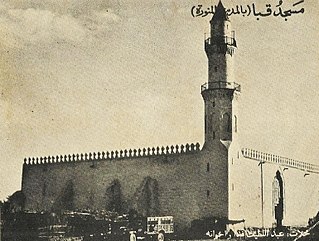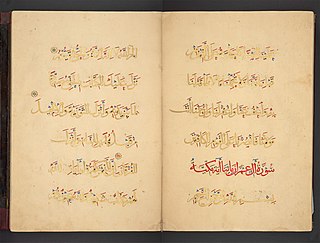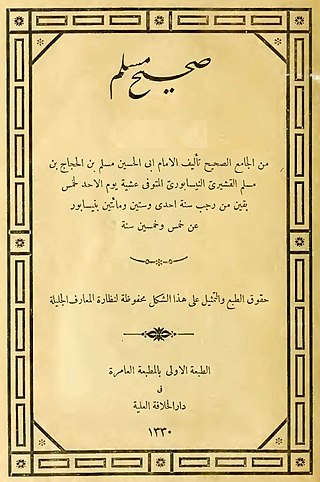
Medina, officially Al-Madinah al-Munawwarah and also commonly simplified as Madīnah or Madinah, is the capital of Medina Province in the Hejaz region of western Saudi Arabia. It is one of the oldest and most important places in Islamic history. One of the most sacred cities in Islam, the population as of 2022 is 1,411,599, making it the fourth-most populous city in the country. Around 58.5% of the population are Saudi citizens and 41.5% are foreigners. Located at the core of the Medina Province in the western reaches of the country, the city is distributed over 589 km2 (227 sq mi), of which 293 km2 (113 sq mi) constitutes the city's urban area, while the rest is occupied by the Hejaz Mountains, empty valleys, agricultural spaces and older dormant volcanoes.

The Quba Mosque is a mosque located in Medina, in the Hejazi region of Saudi Arabia, built in the lifetime of the Islamic prophet Muhammad in the 7th century C.E. It is thought to be the first mosque in the world, built on the first day of Muhammad's emigration to Medina. Its first stone is said to have been laid by the prophet, and the structure completed by his companions.
Abdullah ibn Abd al-Muttalib was the father of the Islamic prophet Muhammad. He was the son of Abd al-Muttalib ibn Hashim and Fatima bint Amr of the Makhzum Clan.

Al Imran is the third chapter (sūrah) of the Quran with two hundred verses (āyāt).
Al-Ghāshiyah is the 88th chapter (surah) of the Qur'an, with 26 ayat or verses. The surah's topics are Paradise, Hell and the miracle of the creation of all things by God.

Sahih al-Bukhari is the first hadith collection of the Six Books of Sunni Islam. It was compiled by Persian scholar al-Bukhari around 846. The author was born in Bukhara in today's Uzbekistan.

Sahih Muslim is the second hadith collection of the Six Books of Sunni Islam. It was compiled by Persian scholar Muslim ibn al-Ḥajjāj.
Abū Hurayra ʿAbd al-Raḥmān ibn Ṣakhr al-Dawsī al-Zahrānī, commonly known as Abū Hurayra, was a companion of the Islamic prophet Muhammad and the most prolific hadith narrator in Sunni Islam.
Zayd ibn Ḥāritha al-Kalbī, was an early Muslim, Sahabi and the adopted son of the Islamic prophet, Muhammad. He is commonly regarded as the fourth person to have accepted Islam, after Muhammad's wife Khadija, Muhammad's cousin Ali, and Muhammad's close companion Abu Bakr. Zayd was a slave that Hakim ibn Hizam, Khadija's nephew, bought for her at a market in Ukaz. Zayd then became her and Muhammad’s adopted son. This father-son status was later annulled after Muhammad married Zayd’s ex-wife, Zaynab bint Jahsh. Aisha the wife of the Prophet, asserts that if Zayd was to live after the Prophet he would have appointed him as Caliph.

Al-Masih ad-Dajjal, otherwise referred to simply as the Dajjal, is an evil figure in Islamic eschatology who will pretend to be the promised Messiah and later claim to be God, appearing before the Day of Judgment according to the Islamic eschatological narrative. The word Dajjal is not mentioned in the Quran, but he is mentioned and described in the Hadith. Corresponding to the Antichrist in Christianity, the Dajjal is said to emerge out in the East, although the specific location varies among the various sources.
Jābir ibn ʿAbd Allāh ibn ʿAmr ibn Ḥarām al-Anṣārī, Abu Muhammad and Abu Abd al-Rahman also wrote his nickname was a prominent companion of the Islamic prophet Muhammad. Imami sources say Jabir was one of Ali's special and chosen companions and one of Hassan, Hussein, Zain al-Abidin and Muhammad Baqir's companions. Jaber narrated hadiths from Abu Bakr, Umar, Ammar ibn Yasir and Muadh ibn Jabal, and he narrated hadiths from young companions including Saʽid al-Khudri and Abu Hurayra. Jabir bin Abdullah also had a scientific reputation among the companions. According to Hisham ibn Urwah, he had a circle for teaching in the Prophet's Mosque, which brought followers around him in connection with the Quran.
The Hadith of Najd is a hadith in Sahih Bukhari with several chains of narration about three geographical locations, one of which is prophesied to be the source of calamities. Sunni Muslims accept that the classification of the hadith as "sahih" (authentic).
Abū Saʿīd Saʿd ibn Mālik ibn Sinān al-Khazrajī al-Khudrī was an inhabitant of Medina and early ally (Ansari) of the Islamic prophet Muhammad and one of the younger "companions of the prophet". Too young to fight at the Battle of Uhud in 625 where his father Malik ibn Sinan fell, he participated in subsequent campaigns. Although he traveled to Syria once to visit the Umayyad caliph Mu'awiya, he resided in Medina all his life. Later, he is said to have participated with his fellow Medinans in the defense of their city against the Umayyad army at the Battle of al-Harrah in 64/683. He is said variously to have died in 63/682, 64/683, 65/684, or 74/693. Abu Saʽid is one of the narrators of hadith most frequently quoted. By one count, he has 1170 narrations, making him the seventh most prolific Companion in the transmission of the hadith.
Muhammad ibn Muslim ibn Ubaydullah ibn Abdullah ibn Shihab az-Zuhri, also referred to as Ibn Shihab or az-Zuhri, was a tabi'i Arab jurist and traditionist credited with pioneering the development of sīra-maghazi and hadith literature.
Miracles of Muhammad are miraculous happenings attributed to the Islamic prophet Muhammad.
Baraka bint Thaʿlaba, commonly known by her kunya Umm Ayman, was an early Muslim and companion of the Islamic prophet Muhammad.

Hadith terminology is the body of terminology in Islam which specifies the acceptability of the sayings (hadith) attributed to the Islamic prophet Muhammad by other early Islamic figures of significance such as the companions and followers/successors. Individual terms distinguish between those hadith considered rightfully attributed to their source or detail the faults of those of dubious provenance. Formally, it has been defined by Ibn Hajar al-Asqalani as: "knowledge of the principles by which the condition of the narrator and the narrated are determined." This page comprises the primary terminology used within hadith studies.

The signs of the appearance of the Mahdi are the collection of events, according to Islamic eschatology, that will occur before the arrival of the Mahdi, The signs differ based on Sunni and Shia branches of Islam.

Al Romat Mountain, or Aynin Mountain, is a small mountain adjacent to Mount Uhud, about three kilometers north of the Prophet's Mosque near Medina. It is the mountain where Muhammad, in the Battle of Uhud, stationed fifty archers to protect the Muslims' rear from the infiltration of the polytheists. The archers disobeyed his orders, thinking that the battle had finished. The polytheists attacked the Muslims, and killed a large number of them.
Wareqan Mountain is one of the Medina region mountains, it is located southwest of Medina, seventy kilometers away on the Al-Hijra highway, and is 2400 meters above sea level and is also known as the Ouf Mountains after the tribe of Bani Ouf from Harb Tribe. Wareqan Mountain was mentioned in the Islamic narrative by Muhammad when he said, "The infidel's tooth on the Day of Judgment is like Uhud, the width of his skin is seventy cubits, his neck is like Al-Bayda, his thigh is like Wareqan, and his seat in the Hellfire is like what between me and Al-Rabadha."








